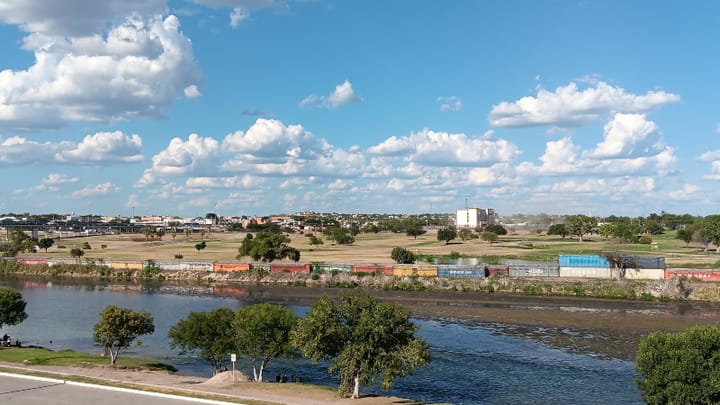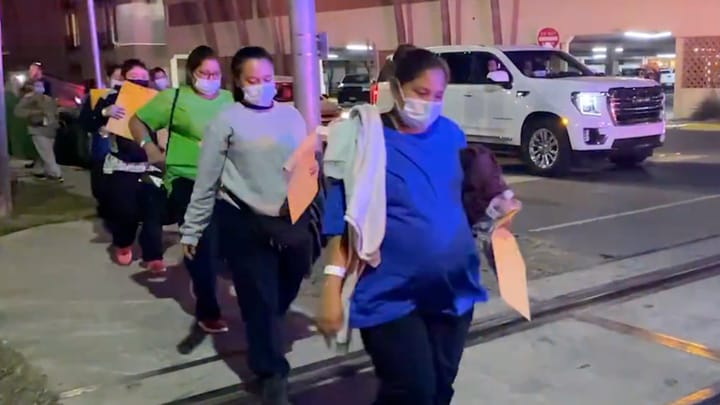CBP, Texas, and El Paso Brace for the End of Title 42

The Supreme Court yesterday indefinitely stayed a district court decision that would have terminated CDC orders directing the expulsion of illegal migrants, issued pursuant to Title 42 of the U.S. Code in response to the Covid-19 pandemic.
Nonetheless, local, state, and federal authorities are bracing for a surge of migrants across the Southwest border when and if Title 42 expires. There is something ironic about waiting for a metaphorical flood in the middle of what is essentially a desert, but that is what’s in the offing.
Title 42. CDC issued its first Title 42 order directing the expulsion of illegal entrants at the land borders to stem the introduction and spread of Covid-19 during the Trump administration in March 2020, shortly after the World Health Organization declared a global pandemic.
Trump didn’t need Title 42 for border-control purposes. In response to a “border emergency” his then-acting DHS secretary declared in March 2019, the 45th president implemented a number of policy initiatives that deterred foreign nationals from entering illegally.
The most prominent, and successful, of those policies was the Migrant Protection Protocols (MPP), better known as “Remain in Mexico”. MPP removed the main incentives for migrants to enter illegally and file bogus asylum claims — the opportunity to live and work in the United States indefinitely — by sending non-Mexican illegal entrants back across the border to await their removal hearings.
In an October 2019 assessment of the program, DHS determined that Remain in Mexico was “an indispensable tool in addressing the ongoing crisis at the southern border and restoring integrity to the immigration system”, particularly as related to alien families.
Border Patrol apprehensions at the Southwest border, which had reached a Trump-era peak in May 2019 (at just short of 133,000), fell below 41,000 four months later — after MPP was fully implemented — before settling at around 30,000 in the first two months of 2020.
The pandemic slowed global migration generally, and Title 42 coupled with those Trump border policies did the rest, leaving Biden with what Rodney Scott, his first Border Patrol chief, described as “arguably the most effective border security in” U.S. history.
It was not to last, as Biden quickly attempted to undo MPP and the rest of Trump’s deterrents.
Remain in Mexico has turned out to be a tough nut to crack, as the states of Texas and Missouri have been fighting it out with the administration in federal court for nearly two years to force DHS to reimplement the program. That said, fewer than 5,500 migrants have been sent back across the border under MPP since Biden took office.
With MPP largely neutralized and the other Trump policies defunct, Title 42 has been the only thing that has stood between simple chaos and an outright humanitarian disaster at the Southwest border. The fate of Title 42 rests with the nine justices of the Supreme Court, which under Chief Justice John Roberts has been reluctant — at best — to interfere with executive branch immigration policies.
On December 27, however, the Court stayed a district court order vacating and enjoining CDC’s Title 42 orders while the justices weigh an intervention request filed by states who are concerned about the impact of the end of Title 42.
The migrants and smugglers appear to understand more about the impact of Title 42 on border security than many in the White House, and with the demise of those CDC orders likely imminent, they are poised to act. As my colleague Todd Bensman recently explained:
If U.S. intelligence estimates are to be believed, a previously unthinkable storm is gathering just off America's borders, portending a potentially permanent transformative impact on the country. And barring a last-minute, unlikely appeal by the Biden administration to delay the elimination of Title 42, America is forecast to take a direct hit.
El Paso. The eye of that storm is centered over El Paso, Texas, though heavy bands are likely to extend over the entire length of the 1,954-mile Southwest border.
That city — the largest on the U.S. side of the Mexican border in terms of population (with just over 705,000 residents at last count) — has already felt its fair share of the impacts of Biden’s feckless and impotent border policies.
In response to the first premature waves of the post-Title 42 migrant flood, the city’s mayor, Oscar Leeser, declared a state of emergency on December 17, which the city council extended for 30 days at a meeting held six days later.
As the Texas Tribune explains, that declaration “allows El Paso to protect migrants by taking them off the streets and putting them in temporary shelters”.
It appears the city is planning to house up to 10,000 migrants, several thousand of them at the local Judson F. Williams Convention Center.
It’s also shipping migrants north. To give you an idea of how bad things are in the city, Leeser — a Democrat who won his job in an officially nonpartisan election — has “teamed up” with Texas’ Republican governor, Greg Abbott, to send busloads of migrants from El Paso to New York City, according to the New York Post.
Leeser’s spokesperson has described those buses as “state-sponsored”, a “part of the requests we have made for transportation support” from Abbott’s office. Bipartisanship lives on the banks of the Rio Grande.
Speaking of the New York Post, on December 26 it revealed that CBP is erecting “a giant tent — bigger than a football field” in the desert outside of El Paso, to supplement the capacity at Border Patrol’s Central Processing Center in the city, which can hold 1,400 migrants. That’s good, because according to the Post, there are 20,000 migrants on the other side of the river waiting to get in.
Running buses is not the only relief that Abbott is offering the city. On December 19, the Texas National Guard (TNG) sent 400 troops, members of the Security Response Force (SRF) of the 606th Military Police Battalion.
A December 19 TNG press release describes the SRF as “a flexible capability for the Texas National Guard trained in Civil Disturbance Operations and Mass Migration Response, used to safeguard the border and repel and turn-back illegal immigrants”.
That’s not all that the TNG has planned, as:
A second Security Response Force from the 236th MP Company remains on high alert, prepared to deploy if needed, to other areas of the border. These actions are part of a larger strategy to use every available tool to fight back against the record-breaking level of illegal immigration and transnational criminal activity.
Included in that “larger strategy” has been TNG’s positioning of shipping containers as barriers along the border in and near El Paso, and the installation of what the Post describes as “three rows of concertina razor wire near a popular border crossing in” the city, all intended to shift the migrant flow through the ports of entry.
It’s an all-out effort by the Texas Military Department. On Christmas Day, Major General Ronald “Win” Burkett tweeted:
Time for Greater Federal Action. It’s time for the federal government to up its efforts. The Post reports that Rep. Veronica Escobar (D-Texas), who represents El Paso, has asked the administration to open nearby Ft. Bliss for migrant housing, but that has not happened, at least not yet.
That’s the practical and concrete. What the Biden administration — which has attempted to end Title 42 and which has asked the Supreme Court to allow those CDC orders to expire — really needs to do is implement policies that would deter foreign nationals from entering illegally to begin with.
As I recently explained, the president already has the authority under section 212(f) of the Immigration and Nationality Act (INA) to expel illegal migrants as an immigration and border security policy, not on assailable public-health grounds as Title 42 intended.
That would be the ultimate deterrent to both those migrants and to the smugglers who are facilitating their illicit entries. Thus far, however, in a break from every previous administration, the current one has rejected any form of deterrence as a border strategy.
Instead, Biden wants to allow any and all foreign nationals to enter the United States illegally to enable them to apply for asylum — regardless of whether they have valid asylum claims or come seeking asylum at all.
Respectfully, that’s pretzel logic, like allowing criminals to commit burglary to ensure that they can receive due process in subsequent criminal proceedings. As my colleague Mark Krikorian has explained, however, that’s the administration’s plan because Biden’s staffers equate the INA with Jim Crow.
“I Was Misinformed”. Consequently, we are faced with the prospect of a metaphorical flood of migrants in the Texas desert, abetted by ideologically driven policies that are being continued regardless of the inevitably deleterious consequences.
It reminds me of a scene in the 1942 Oscar-winning film, Casablanca, where the collaborationist police Captain Louis Renault (Claude Rains) asks bar owner (and hero protagonist) Rick Blaine (Humphrey Bogart) how he ended up in the titular city:
Renault: What in heaven's name brought you to Casablanca?
Rick: My health. I came to Casablanca for the waters.
Renault: The waters? What waters? We're in the desert.
Rick: I was misinformed.
Not to spoil things if you’ve never seen the movie, but Rick is lying — he came to Casablanca to escape his doomed love for Ilsa Lund (Ingrid Bergman), who is now married to Czech resistance leader Victor Laszlo (Paul Henreid).
Joe Biden’s the protagonist in the true-life drama playing out in the Texas desert in El Paso, but he’s no hero in this tale. And it’s the Americans who are being told, by the White House press secretary and others, that the Southwest border won’t be open once Title 42 ends who are being “misinformed”.
This article was originally published by the Center for Immigration Studies.
Visit BorderHawk.news




